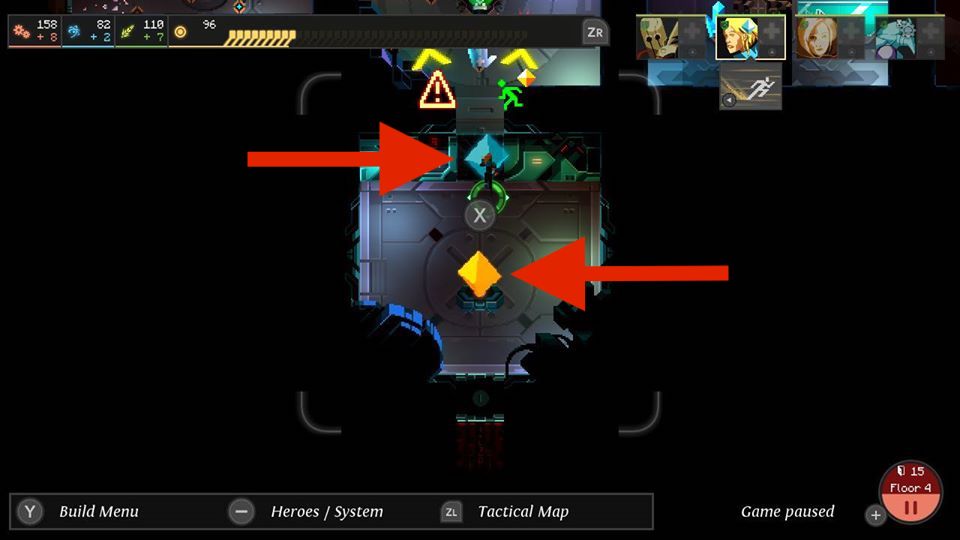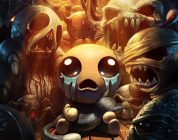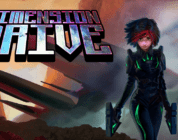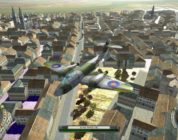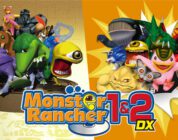Dungeon of the Endless originally released back in 2014, so Amplitude Studios has had plenty of time to work out the kinks in the system. Unfortunately, though, that does not seem to have translated to the title’s port to the Nintendo Switch. While Dungeon of the Endless is still a wonderfully balanced, addicting, challenging, and in many ways rewarding game, it has two bugs on the Switch that make it not worth playing. Hopefully, Amplitude will bring in some patches to fix them right away and this review’s complaints (written on April 30th) will be largely obsolete by the time the title fully releases.
The Premise
At the start of each game, we see a very Star Wars: A New Hope-style intro. Floating into view from the top of the screen is a massive prison transport, bombarded by an unseen attacker. From there, various sections of the ship break apart and fall like stars toward an alien world, releasing prisoners and wardens alike. It is then that you can start choosing your characters and game settings. Immediately, the in-game text shows a penchant for snark and sarcasm that made me want to fall in love with it. Heck, you can play as a genius, borderline psychotic “War Pug,” for crying out loud! How awesome is that?!
In the opening menu, you choose two characters to begin with and a type of game to play. Each game mode has various modifications. For example, if you decide that you escaped in the remnants of the Infirmary Pod, healing your heroes will cost fewer resources, but they cannot heal automatically. In order to unlock additional modes, however, you must first win a vanilla game by choosing the Escape Pod. From there, you choose whether you want to play in “Easy” mode or “Too Easy.” Now, I don’t know who decided to title those options, but they are a cruel and twisted individual. “Easy” mode handed my hiney to me within six levels of the thirteen-level game and I still haven’t even managed to finish a single run on Too Easy, though more on why later.
The Game Itself
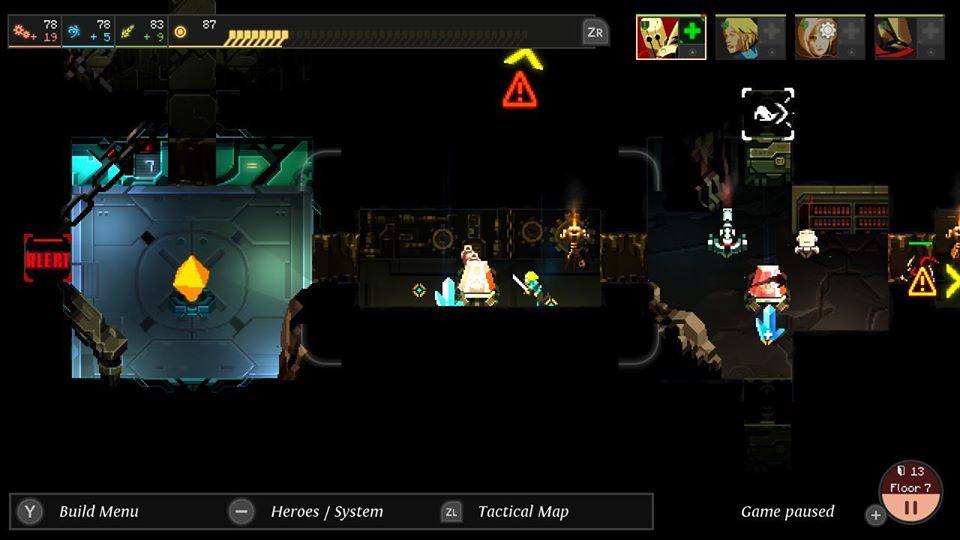
See those little exclamation points? Those mean that monsters have spawned to mess my stuff up. As for the alerts and little white icon, I’ve never figured out what that means. Figured there were monsters trying to break down the doors, but it never happened…
Dungeon of the Endless is certainly endless but is a bit light on the “dungeon” part. Once you start playing, your prison vessel (or floating “dungeon”) is nowhere to be seen. Dungeon of the Endless, as a roguelike, creates procedurally generated levels. This makes everything a little different each time you play and provides nearly “endless” possibilities. Your goal is simply to transport your crystal, the power source that operates lights and your turret defenses, to the elevator leading to the next floor as infinite waves of enemies pursue you. Simple, yes, but by no means easy.
You can only light so many rooms at a time and must manage your resources; industry (for making turrets and other support structures), science (for upgrading your constructions and learning new ones), food (for healing and leveling up your characters), and dust, which your crystal needs to power each room. Much of the game revolves around trying to strike a balance between creating a defensible route for your heroes to traverse and saving those resources for later, harder levels. Furthermore, if that crystal is damaged, you permanently lose dust. Losing dust means that random rooms lose power, which often shuts down defenses. If you run out of dust entirely, even if your party is still alive, it’s game over.
In terms of base mechanics, Dungeon of the Endless works beautifully. As an adventure, roguelike, turret-defense game, the gameplay and balancing are well done. While some characters and defenses feel underpowered, their shortcomings can often be compensated by the right teammate or support structure. The exploration aspect is also suspenseful, as you never know whether the next room you open will have resources or release a wave of flesh-eating monstrosities. The resource management is multifaceted, yet simple to follow, and the moment of truth when one of your characters sprints with the crystal to the elevator leaves you on tenterhooks as you hope and pray that you have sufficiently prepared your units and the path they must traverse. As mentioned before, there are also new game modes to unlock and a cast of characters to discover with a wide array of abilities to experiment with. In short, this game is all about replay value and, man, it is absorbing!
Unfortunately, the game expects you to remember which abilities each character learns as they level up. Since there about as many abilities in the game as there are fleas on my middle school math teacher and you never know which characters you will recruit along the way, there is no shame in checking a wiki to see what abilities will unlock as you level up. Besides, it is difficult or nearly impossible to distinguish who the strangers you find in the dungeon are, since the character sprites are small and often in dark rooms. You will sometimes need to look up their names to know who is who and whether you want them on your team.
The Problems
My only qualm with the game itself, to be honest, is the lack of character development. Each “hero” comes with a biography, often complete with that beloved sarcasm that I mentioned earlier. We learn something about their past, motivations, and how they ended up on this doomed prison transport. Unfortunately, this is where the design itself starts to slip. Sure, story and character development are not a major part of the roguelike genre, but Amplitude Studios gave us a teaser. We know something about each character and why they want to survive, or what they want to get out of this adventure. You can even learn more about them if you complete a level with the right characters paired together in the party. If that happens, you unlock some dialogue between them, which reveals a little bit about both speakers. However, you never find out more than some odd trivia, so far as I can tell, and there is no tension between former prisoners and jailers. It just feels like they are chatting at the water cooler about a poker match, rather than discussing lifelong incarceration. Then again, this may be because I never successfully finished a single run of the game, which brings me to my next point.
The Switch port of Dungeon of the Endless has two game-breaking bugs. The first and most common one is what I like to call the Coupled Crystal Kerfuffle. Normally, when one of your heroes picks up the crystal, it is as simple as that. They pick it up and run. Sometimes, however, they will pick up the crystal, but somehow the original crystal will remain in place while they carry the other. That means that, while one of your characters is carrying what should be the only crystal on the map and running like an Olympic torchbearer who just realized that there’s a pack of hyenas chasing them, there is a second crystal being assaulted.
This happens randomly, so you cannot consistently plan for it. If you do plan for it, laying extra defenses and creating a staggered retreat pattern, your heroes are at higher risk and you burn a ton of resources, all for something that may or may not happen. Can you imagine how frustrating that is, discovering that you have wasted most of your resources for nothing and then starting the next level with the space-age equivalent of a fly swatter and an angry possum on your side? Since this game has been out for a while, I decided to check various forums to see if this was in fact a deliberate feature. However, I could find no mention of this phenomenon cropping up. This inclines me to believe that it is simply a bug.
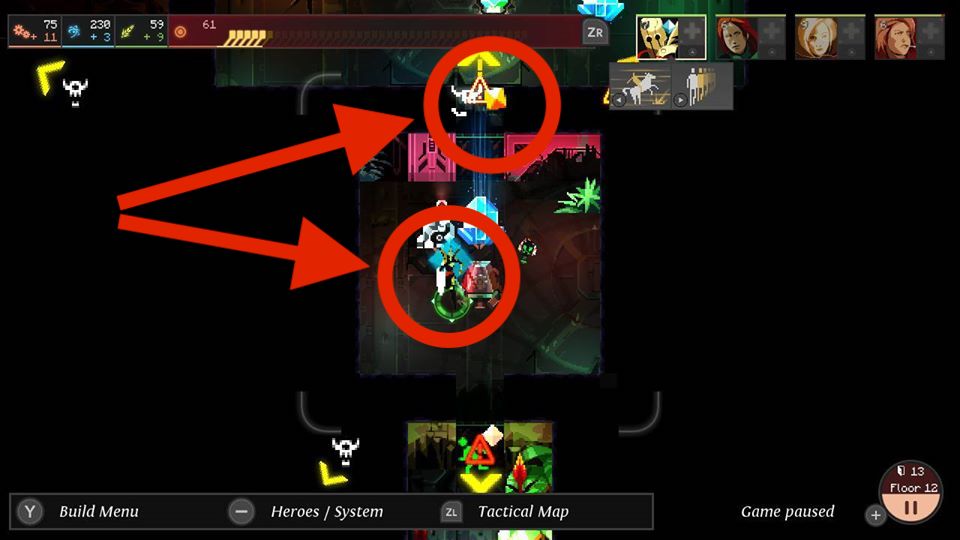
See that icon circled up top? That shows that a monster is attacking my crystal in the starting room. The bar above it is red, meaning that I am losing dust and power for my defenses because of this assault. However, my hero has the crystal in their hands, so riddle me that one! Bet you can figure out how I lost during this last level of the game.
Then there is the second and rarer, but far more terrible bug: The complete software crash. Thrice has my copy of Dungeon of the Endless crashed on me. I bought my Switch new three months ago and it ran Breath of the Wild like a dream, yet this pixel-art game crashes repeatedly. Once might be bad luck, which I have an abundance of, but three times is indicative that something is wrong with the software. To make it worse, the game has no auto-save function. If you quit the game without saving, your ENTIRE run is deleted, including all of the progress you have made toward unlocking characters, game modes, and dialogue. If your game crashes on you, it is much the same result.
When the game crashed for the third time on the seventh out of thirteen levels, I just decided that I had had enough. “I’m done,” I thought, zipping up my Switch case and pulling out a book instead.
The randomness of a roguelike is a gamble as it is, but if there’s a decent chance that the game is going to either glitch and have two crystals or just straight up delete my progress, then I’m not wasting my time.
The Smaller Problems
My other criticisms of the Switch port are more nitpicky. To begin with, the interface was clearly made for a PC. If you want a hero to do something, then you can select them individually easily enough. If you want all of them to do the same thing, that is also easy. However, if you want them to do independent actions or have two do one thing and then the others do something else, then you have to cycle through each hero, pan around the entire map to find where you want them to go, and then pan all the way back to the next character you want to control. It’s tedious and could have been fixed with some adjustments to the controls, but this is not a deal-breaker.
Also, sounds can sometimes go absolutely batty. In one case, everything except for the ambient sound effects cut out and the remaining sounds was cranked up to eleven with an emphasis on the high-pitched feedback. Sure, a little bit of tinnitus never killed anyone, but I had no desire to listen to that for the whole five levels that it persisted.
As for roguelikes themselves, I am simply not a fan of that much gambling. Now don’t get me wrong, generated worlds can be a lot of fun. Look at Minecraft, where every world has its own environments and presents something new to explore. However, in many roguelikes and their ilk, there is too much chance involved to always feel fair. There is always the possibility that you will just get absurdly unlucky, suffer perma-death, and then have no way to recoup your losses. That happened to me during one play-through of Dungeon of the Endless. I explored eight rooms, yet gathered none of the dust needed to power my defenses or prevent enemies from spawning. Mind you, dust is something that you can usually run across every three or four rooms. Just like that, though, I was swamped with waves of enemies that I had no way of defending against.
Roguelikes, with some rare exceptions, are too unforgiving in this aspect. They punish you, not because of any failure as a player or strategist, but simply because of bad luck. If I wanted that kind of experience, I would simply blow my money in Vegas or try my hand at the stock market. While the roguelike model may be an accurate allegory for how unfair life can be, it is not, in my opinion, a great game mechanic if unregulated. By the same token, you can also be unjustifiably fortunate and the run becomes smooth sailing. Rather than feeling like a reprieve, though, that usually feels like you didn’t really deserve to win.
The Last Word
The thing is, I like Dungeon of the Endless. I mean, I REALLY like it. I’ve been playing turret defense and adventure RPG games since I was a little kid and Amplitude managed to merge them into an engrossing game! If it was not for the software issues, I would give it a nearly full endorsement. Personally, I usually require a video game to have a compelling story or character development, or else I get bored, but Dungeon of the Endless was fun enough on its own that I could forget about my need for a narrative. However, those bugs that I mentioned effectively break the game, and I sincerely hope that Amplitude fixes them. I would love to play more without fear that the game will simply shut down on me.
With the hope that these issues will be fixed, I have rated the game as if the bugs do not exist.
More information about Dungeon of the Endless can be found on the official Nintendo eShop listing. A digital Switch copy was provided for the purpose of review.


